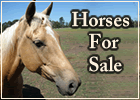

Training a Horse to Accept Gunfire
With gunfire you are dealing with two issues, volume of sound and distance from horse. Any horse could probably handle a low volume sound at a great distance from them so you start there in the gunfire training. I will turn the horse loose in the round pen then move 100 yards away from the round pen and begin firing percussion caps only with no powder load. (You need a black powder percussion pistol for this.)
I'll fire a few and watch for the horse's reaction. If there is little or no reaction I'll move 10 or 20 feet closer to the round pen and fire a few more watching for a reaction from the horse. I'll continue this process moving closer with every few shots. As I shoot I'll aim the pistol in different directions so it sounds different to the horse - up, down, right, left, and toward the horse but never directly at the horse. If I ever see a reaction of fear or panic (running around with head up and big eyes) I'll move back closer to the previous distance and fire more shots from there until the horse ignores the sound.
Once I've worked my way up to the round pen fence and the horse is pretty much ignoring the caps firing then I'll go just inside the round pen and continue firing. As long as the horse is not bothered I'll continue to fire and move closer to him. At this point I might put a 12 foot lead rope on the horse to see if I can support him to stay with me while I fire more caps. If the horse ever starts to panic and run around I'll go back closer to the last place where we were successful and do more firing until the horse becomes calm.
By the time I am standing right next to the horse firing caps he has now heard several hundred caps fired and has become comfortable with the fact that nothing bad is going to happen to him when a cap is fired. When I'm standing next to him holding the lead rope, I will be standing beside the shoulder facing forward and will always aim the pistol away from the horse. I will fire while standing on both sides of the horse.
After the horse is comfortable and ignoring the firing with me standing right beside his shoulder I will go back out 100 yards from the round pen and begin the entire process again this time firing 1/4 loads or about 6 grains of black powder as poured from a powder measure. Now the horse will not only hear the shot but will also see the smoke. I'll continue this gradual "moving closer/firing 1/4 loads" process until I am once again doing this while standing next to the horse holding the lead rope.
I'll repeat this entire process next using half loads (12 grains) then 3/4 loads (18 grains) then full loads (24 grains).
Once this is complete the horse will have heard several hundred shots fired of varying intensity and should be unperturbed by this gunfire in his neighborhood and close vicinity. Now I will mount up in the round pen and fire caps only from the saddle until the horse is comfortable and standing quietly while I fire caps. Next I will fire 1/4 loads from the saddle pointing the pistol off to the right, left and rear. I'll continue firing 1/4 loads until the horse is standing calmly. He might jerk his head a little when the shot goes off but he should not move his feet. If he starts to move and you can check him with very slight rein pressure, that is acceptable. From here I'll repeat this process with 1/2 loads, then 3/4 loads then full loads. By the time I am firing full loads from the saddle the horse has probably heard over 1,000 rounds fired and should be quite comfortable with gunfire from the saddle.
This entire process should be done over a period of several weeks in a number of short sessions. This should only be attempted with a solid, well trained and well mannered, mature riding horse. Stay safe, be careful, take plenty of time, shoot more than you think you need to and know you can always back up to the last place that was successful and work more there.

Ed Dabney is an internationally acclaimed clinician, presenting horsemanship and riding clinics all over the US and in Europe. In 2007, Ed was named Champion of the East Coast Trainer Challenge Series by Equine Extravaganza. Ed was honored to have been selected by the University of Georgia to teach their senior level Young Horse Training course.
His training articles have appeared in many major national magazines. Ed produces instructional videos and the “Gentle Horsemanship” TV program which has been seen on RFD-TV.
Ed's blending of natural horsemanship and classical equitation has made an indelible mark with students all across the United States and now also in Europe, drawing the attention of serious riders searching for the lightest touch and the deepest connection with their horses irrespective of breed or discipline.


